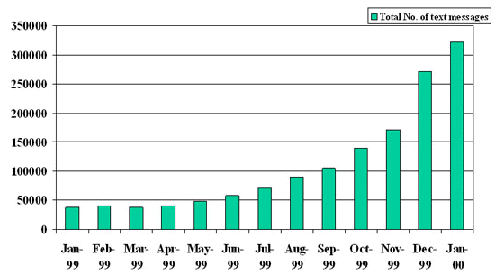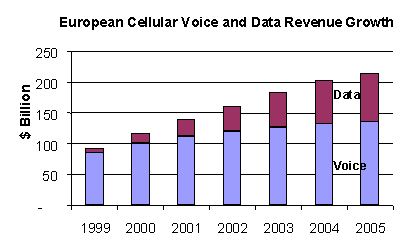Introduction: The Market for Mobile Computing
Overview
Mobile computing is not new. Large enterprises have been enabling mobile
workers with laptops and modems for over 10 years and mobile data technology
is already being used for a wide variety of applications-electronic mail,
messaging, corporate database access, fax transmission and receipt, job
dispatch, online transactions, and basic file transfer. However, these
deployments have largely been bespoke and fraught with complications, which
have delayed widespread acceptance.
The two biggest constraints-lack of international standards, and a lack of
a popular user application-have been largely removed by the Internet. The
entry-level cost has also deterred growth in the private consumer market,
until the recent introduction of more competitive tariffs, and a pre-pay model
for the use of cellular telephone networks in the 142 countries worldwide
which support the GSM standard.
Wireless data is seen by many as the future of the mobile communications
industry. Mobile operators and Internet service providers have begun to work
together (some organizations such as Vodafone/Airtouch and Sonera are even
declaring themselves as fulfilling both roles) to deliver new wireless data
services which have broad market appeal. Operators are already using the
mobile phone as a device for delivering services other than telephony. In
France, for example, you can already buy a soft drink with your mobile phone.
Vending machines have phone numbers-simply dial the number of the vending
machine and the device delivers your drink, charged to your cellular phone
bill. Although this is not strictly a data application, it is beginning to
shape the behavior of users to expect more from their phone than just talking.
Business applications, such as the provision of access to corporate
intranets, are likely to drive usage of, and revenue generated from, the
wireless Internet due to the user profile of being quality-sensitive and
price-insensitive. However, consumer use will continue to grow rapidly.
Globally, this view has recently been confirmed by two showcase examples: the
exponential growth of Short Message Service (SMS) traffic in the European
youth market, and the dramatic take-up of the NTT DoCoMo service �I-mode�
in Japan.
Within three years, more than 100 million employees around the world will
regularly work outside the boundaries of the enterprise, without the comfort
of continuous LAN or high-speed WAN connections. The workplace will change
forever, and this army of "location-independent" workers will share
one common characteristic. They will be only intermittently connected to the
corporate information systems upon which they depend to do their job. The
trend is evidenced by the huge growth in laptop computing, the deployment of
Personal Digital Assistant devices for corporate applications, remote access
connections, and the use of cellular and packet radio technologies phones for
data.
Over a year ago The Open Group membership requested a specific focus on the
areas of wireless and mobile data. A working group was formed in the spring of
1999 and, following general industry research to identify opportunities for
contribution, The Open Group conducted a six-month study of the wireless
computing market. This study included in-depth interviews with key wireless
technology buyers and suppliers, and drew the conclusion that the enterprise
and wireless markets are converging but still face serious obstacles.
Integration of wireless devices and applications into the enterprise
environment is seriously impeded by the lack of interoperable standards and
solutions. This document records the results of that study and, based on the
feedback received, proposes concrete action by The Open Group and other key
industry leaders to accelerate the full potential of wireless data in the
marketplace.
Wireless and mobile data volumes are rapidly growing in Europe and 1999 can
be regarded as the year when the European market for mobile data services
finally began to achieve some of its much hyped potential. Similar growth has
been replicated throughout the GSM world, and even bettered in the Japan PCS
market. Meanwhile the North American market continues to suffer from the proliferation of
incompatible digital cellular standards, which the �free market anarchy� approach
has nurtured.
Encompassing the full spectrum of data services, from low bandwidth SMS
applications through to high-end mobile multimedia services, we are now seeing
data account for up to 6% of all service revenues on some of Europe�s
cellular networks. The European growth trend in terms of subscription share
between voice and data is reflected in the U.K. market predictions.
U.K. GSM Network Operator Totals 1998-2000
(,000s)

(Source: Mobile Data Association)
Figures released by the MDA in February show that U.K. SMS traffic
increased by over 40m messages per month during January, doubling the figure
reported three months earlier. As in most European countries, the primary
usage of SMS in the U.K. has been in the youth market. Many anecdotes exist
about the way in which teenagers use the service to announce meetings at
coffee bars or cinemas, and how text messages are used as the only way to
communicate between friends in noisy night-clubs.
The European cellular data market is now expected to
increase from $4 billion in 1999 to $60 billion per annum by 2005. Initially
this will be fueled by the continued growth in SMS traffic. In the short to
medium term, 2.5 Generation services, including HSCSD, GPRS, and EDGE
technologies, will have a major role to play in the development of the market
and full 3rd Generation data services are expected to account for
57% of total cellular data service revenues by 2010.

(Source: Ovum 1999)
The dramatic growth of mobile telephony has shown how important it is to
users to have convenience and freedom to talk. The Internet, with it�s
ease-of-use and availability almost to the point of ubiquity in most computing
resources, offers the potential for equally dramatic growth in mobile data.
Technology on its own will not drive the growth of usage and revenue. For
business and consumer users alike, it is applications which deliver valuable
personal utility that will create a willingness, or even a preference, to use
a mobile device for commerce transactions. Low bandwidth data services are
already in demand as can be seen from the uptake of SMS-based messaging and
other consumer-oriented novelty applications. Messaging from short-message to
full email will continue to offer greatest short-medium term utility for
business users and consumers alike.
Beyond this, growing Internet penetration is driving existing Internet
portals, such as AOL and Yahoo, and cellular operators to create new
portal-related content delivery products such as customized, regular delivery
"push services" including sports results, stock market pricing, and
weather data; irregular "pull services" such as cinema listings,
concert programs, and train time requests; and location-based services
including identifying local outlets, cash-point machines, restaurants, and
personal or in-car navigation including congestion avoidance. In line with
wired Internet portals, advertiser sponsorship will be a key driver and
revenue generator for the consumer market, although brand reinforcement on the
currently available screen real estate presents a new set of challenges for
dot com organizations.
High-end "interactive multimedia" applications will ultimately
prevail but there are some limiting factors which must be overcome including
network deployment, terminal design, and availability, and above all
appropriate and acceptable tariffing for the connectivity, data, and services
to be delivered.
All of the building blocks (SMS, WAP, network upgrade paths, flexible
tariffs, new device formats, Internet growth, user awareness) are falling into
place to stimulate greater demand, but there are still some major challenges
which lie ahead. Specifically these are achieving the correct design of
multipurpose mobile devices, overcoming the reliability and interoperability
issues on WAP servers and devices, and ensuring and maintaining the quality of
service and roaming on new "data" networks as they upgrade through
from 2G to 3G.
Given that the growth of mobile data was inhibited by a lack of standards
which analysts claim the Internet has solved, it is curious to note that the
projected growth for the next 24 months is based on the availability and
ease-of-use of two technologies which are new, not sanctioned by any of the
Internet standards groups, and for the most part peculiar to GSM and the
cellular telephone handset. These are Short Message Service and Wireless
Application Protocol.
Whatever solutions are proposed, it will benefit the industry, enterprise,
and consumers alike if the technical elements are accomplished within, or seek
to create, agreed standards which ensure global interoperability, and which
can be subjected to a full conformance testing and certification regime.

